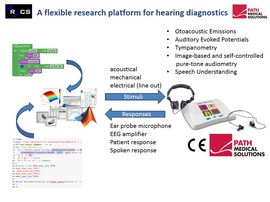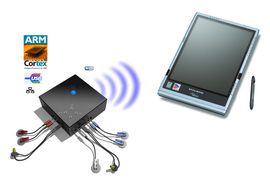Methods in audiological diagnostics
«The inability to see separates from things, the inability to hear separates from humans.» Immanuel Kant
Hearing disorders are diagnosed using subjective and objective test methods. Both types of audiometry uses acoustic stimuli which are presented to the patient’s ear. The response can be either a subjective reaction of the patient such as to press a button, or it can be a physiological reaction that can be measured objectively such as the acoustic reflex of the stapedial muscle. The aims of both, subjective and objective audiometry, are the assessment, the localization and the quantification of hearing loss.
Subjective audiometry includes:
- pure tone audiometry
- image based audiometry
- speech audiometry
Objective audiometry includes:
- Otoacoustic Emissions (OAE): sound emissions which are generated by non-linear distortions of the outer hair cells in the inner ear
- Auditory Evoked Potentials (AEP): very small electrical voltage potentials which are recorded in response to an auditory stimulus from electrodes placed on the scalp (similar to an EEG (Electroencephalography)).
- Tympanometry: used to measure the resistance of the eardrum and middle ear towards sound
We focus on the development of audiometric measurement platforms which combine the entire audiometric test battery to allow complete, fast and automated diagnosis of hearing.
We develop hard- and software for modern CE-certified test equipment, which allows researchers and users to create their own stimuli and recoding algorithms. An easy-to-use and flexible programming interface provides the opportunity to either implement new algorithms via graphical programming tools (like “blockly”) and/or via conventional programming techniques (e.g. Matlab). The test equipment is operable via a web-interface for flexible use with various control units just having a web browser (e.g. PC, laptop, tablet, smartphone).
The main components of the system are:
- NXP LPC4330 dual-core ARM Cortex M4/M0 processor
- Multichannel audio-interface
- Microphone amplifiers
- Biopotential amplifiers
- Fast communication interfaces to PC: USB 2.0, Ethernet, WLAN
In cooperation with the company PATH medical GmbH we deal with the following topics in this field of research
- Hardware design for medical devices (analog HW, digital HW, PCB layout with Eagle 6)
- Dual-Core ARM programming using C/C+
- Audio signal processing
PC-Software design (medical-certified software), Matlab, HTML5
Graphical programming techniques
Development of new strategies and methods in audiology
Combination of measurement methods that complement each other
Telemedicine
Contact
Thomas Rosner

